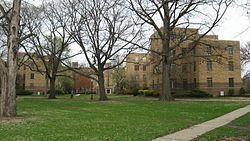Architectural style International Style Area 4 ha Added to NRHP 28 February 1983 | NRHP Reference # 83000133 Year built 1935 | |
 | ||
Architect Russ, William E.; Harrison, Merritt | ||
Lockefield gardens standard 1 bedroom apartment tour
Lockefield Gardens was the first public housing built in Indianapolis. Built during the years of 1935 to 1938, it was built exclusively for low income blacks in Indianapolis. The complex was closed in 1976, and a number of structures were demolished in the early 1980s. Today, the only original structures remaining are those along Blake Street.
Contents
- Lockefield gardens standard 1 bedroom apartment tour
- Lockefield gardens apartments video tour
- History
- Today
- References
Lockefield gardens apartments video tour
History
Due to Franklin Delano Roosevelt's New Deal, the Public Works Administration started funding fifty low-cost public housing projects in twenty states from what were previously slum areas. Indianapolis was chosen to have one of these renovations; it would be the first major public housing within Indiana's capital city. This land originally had 363 residences, of which only one was seen as "habitable". Another goal of the project was to provide temporary construction jobs in the area, 9,000 in total. This was done despite the wishes of Indiana congressmen, as they feared that private enterprises would be hurt by federal projects such as this.
Three million dollars was spent on the Lockefield Gardens project, which opened in February 1938. Twenty-two acres along Indiana Avenue were chosen to become 748 separate housing units, under the direction of the Russ and Harrison architecture firm, built by N. P. Severin Company of Chicago, based on European prototypes. The twenty-four buildings which made up the complex ranged from two to four stories. "Corner", "strip", and "tee" models used by the Public Works Administration in other projects were used here. Among the amenities of this housing were a central mall, four playgrounds (with thirteen smaller play areas), a school (William D. McCoy Public School #24), and a small shopping arcade. It featured plenty of ventilation, abundant natural sunlight, and pleasant views of the area. Rents ranged from $20.80 to $30.10 a month. Lionel Artis was chosen as the original apartment housing manager, a position he held until his retirement in 1969, a span of over thirty years. After construction, it was considered one of the best of the New Deal housing projects. The spacious, wide-open areas of Lockefield Gardens were an oddity; other New Deal housing projects were cramped.
When it originally opened, Lockefield Gardens was racially segregated, but it allowed blacks something they rarely had: a community-oriented residence. Lockefield Gardens became the nucleus of black community located immediately northwest of downtown Indianapolis. In the 1950s, as racial equality improved, blacks began moving to what were residential areas mostly inhabited by whites. Due to income restrictions and more prosperous blacks leaving for the white residences, Lockefield Gardens began its decline. A redevelopment plan in the 1970s was hoped to revitalize the district, but federal judge S. Hugh Dillin thought it would lead to continued segregation of an educational and residential level. As a result, the apartments closed in 1976.
In 1980 it was decided that, in addition to an immediate need to house athletes from the Pan Am Games being hosted in Indianapolis, part of the Lockefield Gardens area would be used for the expansion of Indiana University-Purdue University Indianapolis (IUPUI), a campus of both the Indiana University and Purdue University systems. In 1983, after demolitions, only units along Blake Street and Locke Street (now University Boulevard), out of the original twenty-four buildings, remained, despite protests by Indianapolis preservationists. Even still, the remaining structures were placed on the National Register of Historic Places. Eleven new buildings were made, and the original buildings were renovated. The new total housing units of the complex was 493, with 199 of this total being within the original structures.
Today
The area now serves as an apartment complex on the IUPUI university campus, although urban professionals are invited to live there as well.
